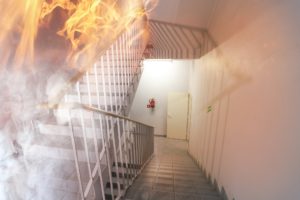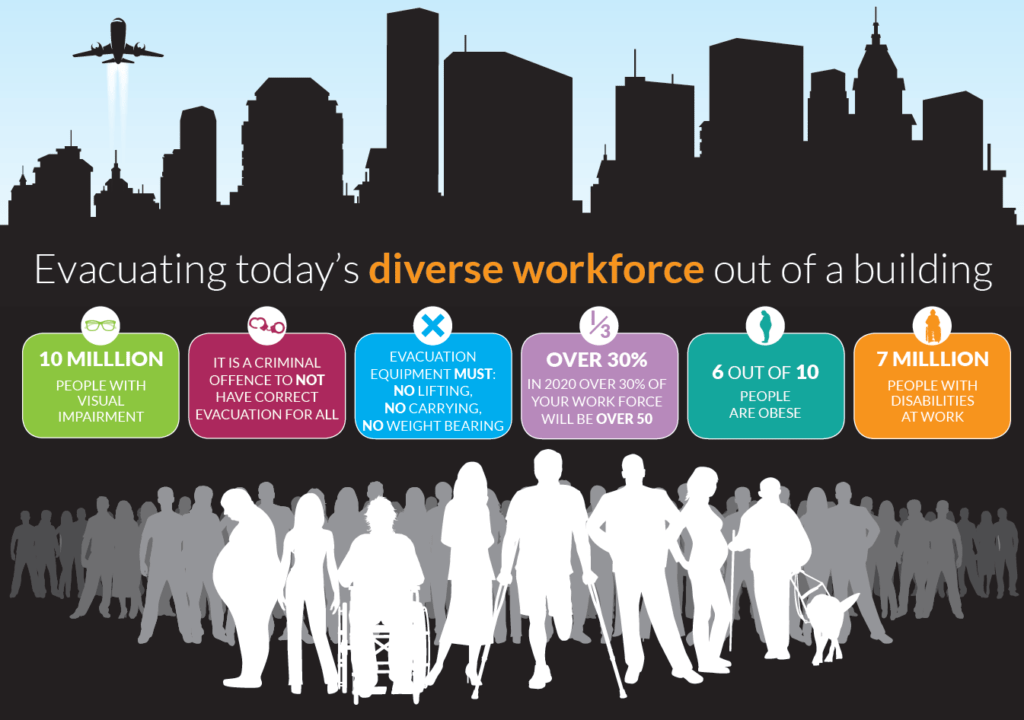As a health & safety manager, what should be top of your priorities when evacuating? Gerard Wallace, Managing Director at Evac+Chair, lists his ‘high five’.
Everyone is your responsibility
It is the employer’s or service provider’s responsibility to evacuate all people from a building in an emergency – that means it is no longer the responsibility of the fire service to facilitate the evacuation of non-domestic premises.
Neglect to prepare properly for evacuating employees, visitors, students or the mobility-impaired and you can be found guilty of failing to provide a duty of care which carries a charge of corporate manslaughter in work-place cases.
Who have you trained?
 Evacuation procedures should be set in place along with designated, trained, team members who will assist those in need during the evacuation process. Those employees must undergo practical training in the operation of any evacuation equipment.
Evacuation procedures should be set in place along with designated, trained, team members who will assist those in need during the evacuation process. Those employees must undergo practical training in the operation of any evacuation equipment.
They should practice using this equipment when an evacuation drill takes place – at recommended six monthly intervals.
Keep an eye on your PEEP
Planning is essential, as is ensuring the needs of all employees, visitors and the mobility-impaired are identified. A Personal Emergency Evacuation Plan, known as a ‘PEEP’ or a ‘GEEP’ (General Emergency Evacuation Plan), must be devised by the relevant person responsible to comply with the Fire Safety Order.
Questions your PEEP needs to answer:
- Can a wheelchair user be accommodated with emergency evacuation chairs?
- How might my team transfer the wheelchair user into an emergency assistive device?
- How do I establish if the wheelchair user is prepared to be evacuated?
All very simple questions that wouldn’t want to be addressed during the real event where the fire time-line is being eaten into by every deliberation.
Practice, practice and practice
The plan should be tested in regular drills, to ensure all staff involved are aware of the procedures and have received a copy of the relevant PEEP. When planning for an emergency in a public access building where mobility-impaired or people with disabilities have total access, a PEEP would be insufficient. The responsible person would need to devise a GEEP to accommodate the needs of everyone.
What about the vulnerable?
Evacuation chairs have proved to be the most efficient and user-friendly, enabling the operator and passenger to safely exit the building. Due to more than one person possibly needing assistance, other types of evacuation product may be required such as slide sheets, rescue mats or stretchers in addition to evacuation chairs.
All evacuation aids must be located in a designated refuge point which is specified in the buildings fire strategy. Each fire exit has to accommodate the able-bodied and mobility-impaired therefore all equipment has to be readily available and accessible at the refuge point.

Fire Safety in 2023 eBook
SHP's sister site, IFSEC Insider has released its annual Fire Safety Report for 2023, keeping you up to date with the biggest news and prosecution stories from around the industry.
Chapters include important updates such as the Fire Safety (England) Regulations 2022 and an overview of the new British Standard for the digital management of fire safety information.
Plus, explore the growing risks of lithium-ion battery fires and hear from experts in disability evacuation and social housing.

 Evacuation procedures should be set in place along with designated, trained, team members who will assist those in need during the evacuation process. Those employees must undergo practical training in the operation of any evacuation equipment.
Evacuation procedures should be set in place along with designated, trained, team members who will assist those in need during the evacuation process. Those employees must undergo practical training in the operation of any evacuation equipment.
